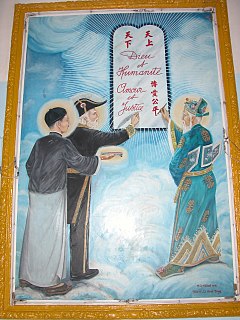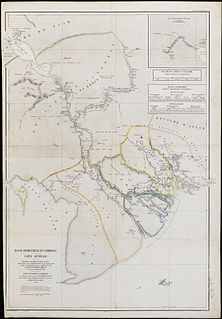
Vietnam's recorded history dates back to the mid-to-late 3rd century BC, when Âu Lạc and Nanyue were established. Northern Vietnam was since the late third millennium BC populated by early farming communities, that had expanded from the original centers of rice and millet domestication in the Yangzi and Yellow River valleys. The Red River valley formed a natural geographic and economic unit, bounded to the north and west by mountains and jungles, to the east by the sea and to the south by the Red River Delta. According to legends, the first Vietnamese state was founded in 2879 BC, but archaeological studies suggest development towards chiefdoms during the late Bronze Age Đông Sơn culture.

The Red River, also known as the Hồng Hà and Sông Cái (lit. "Mother River") in Vietnamese and the Yuan River in Chinese, is a river that flows from Yunnan in Southwest China through northern Vietnam to the Gulf of Tonkin. According to C. Michael Hogan, the associated Red River Fault was instrumental in forming the entire South China Sea at least as early as 37 million years before present.
Articles related to Vietnam and Vietnamese culture include:

Phú Quốc, is the largest island in Vietnam. Phú Quốc and nearby islands, along with distant Thổ Chu Islands, is part of Kiên Giang Province as Phú Quốc District, the island has a total area of 574 square kilometres (222 sq mi) and a permanent population of approximately 103,000. Located in the Gulf of Thailand, the district of Phú Quốc includes the island proper and 21 smaller islets. Dương Đông town, is located on the west coast, and is also the administrative and largest town on the island. The other township is An Thoi on the southern tip of the island.

Lý Nhân Tông, given name Lý Càn Đức, was the fourth emperor of the Lý Dynasty, reigning over Vietnam from 1072 to his death in 1128. Succeeding his father Lý Thánh Tông at the age of 7, during his early reign Lý Nhân Tông ruled with the assistance of his mother Ỷ Lan and the chancellor Lý Đạo Thành who were both considered competent regents and were able to help the emperor maintain the country's prosperity. Appreciated as a great emperor of the Lý Dynasty, Lý Nhân Tông made important contributions to the development of Đại Việt, especially for establishing Confucianism as the official philosophy of the state, creating Confucian-based imperial exams, and creating schools based on the Confucian system of learning During his 55-year reign, which was the longest reign for any Vietnamese monarch, Lý Nhân Tông also experienced several wars against Đại Việt's neighbours, the Song Dynasty and the kingdom of Champa in which the Lý–Song War (1075–1076) was the fiercest.

Bắc Giang is a city in Vietnam. It is the capital of Bắc Giang Province. Its name, deriving from that of the Province Sino-Vietnamese, means "north of the river." The location is very convenient for transportation, it is 50 km north of Hanoi, in the middle position on major transportation routes connecting Hanoi with the Lang Son City and Dong Dang international border gate; Bac Giang locates in an important transportation hub. The Thương River runs through the town's southern part heading for Haiphong.

Hà Giang is a city located on the banks of the Lô River in the north-east region of Vietnam. It is the capital of Hà Giang Province. The city has an area of 135.33 km² and a population of 71,689 inhabitants. The population is composed of 22 different ethnicities, of which 55.7% are Kinh and Tày people.

The Hanoi Opera House, or the Grand Opera House is an opera house in central Hanoi, Vietnam. It was erected by the French colonial administration between 1901 and 1911.

Northern Vietnam, Central Vietnam and Southern Vietnam are historic, geographic and cultural regions within Vietnam. Each region consists of subregions, with considerable cultural differences between subregions.

National Route 1A is the trans-Vietnam highway. The route begins at km 0 at Huu Nghi Quan Border Gate near the China-Vietnam border. The route ends at at Năm Căn township in Cà Mau Province.
Sắc Tứ Tam Bảo Temple is an historic Buddhist temple in Rạch Giá, a town in Kiên Giang Province in the Mekong Delta region of southern Vietnam. It is one of two famous temples of the same name in Kiên Giang, the other being in Ha Tien.
Thuận Hóa was a historic territory in central Vietnam. It consisted of the modern provinces of Quảng Bình, Quảng Trị, and Thừa Thiên–Huế.
Emperor Lý Anh Tông (1136–1175) of Đại Việt, was the sixth ruler of the later Lý Dynasty, from 1138 until his death in 1175. Since Lý Anh Tông, given name Lý Thiên Tộ (李天祚), was chosen as the successor of his father Lý Thần Tông at the age of only two, the early period of his reign witnessed the dominant position of Đỗ Anh Vũ in the royal court until his death in 1157, afterwards the Emperor ruled the country with the assistance of a prominent official named Tô Hiến Thành. The reign of Lý Anh Tông was considered the last relatively stable period of the Lý Dynasty before the turbulence during the reign of Lý Cao Tông.
Lý Thần Tông (1116–1138), given name Lý Dương Hoán, was the fifth emperor of the Lý Dynasty, reigning over Vietnam from 1127 to his death in 1138. Becoming the ruler of Đại Việt at the age of twelve, Lý Thần Tông successfully maintained the order of the royal court and strengthened the stability of the country with the assistance of capable officials. For that reason, Đại Việt under Lý Thần Tông was able to witness a peaceful period like during the reign of his predecessors. However, Lý Thần Tông died at age 23 before passing the throne to his crown prince Lý Thiên Tộ.
Ỷ Lan or Empress Mother Linh Nhân was a Vietnamese regent, the imperial concubine of Lý Thánh Tông, the third emperor and the natural mother of Lý Nhân Tông, the fourth emperor of the Lý Dynasty. She served as regent during the absence of her spouse in 1066-68, and as co-regent during the reign of her son in 1073-1117.
2nd Corps or Hương Giang Corps is one of the four regular army corps of the Vietnam People's Army. First organised in 1974 during the Vietnam War, 2nd Corps had a major role in the Ho Chi Minh Campaign that ended the war. Today the corps is stationed in Lạng Giang District, Bắc Giang.

Dương Thị Ngọc Vân courtesy name Vân Nga (雲娥) was the only empress dowager of the Đinh Dynasty and afterwards empress of Lê Đại Hành, the first emperor of the Early Lê Dynasty. When her husband Đinh Tiên Hoàng was assassinated in 979, Dương Vân Nga became the Empress Dowager of the Đinh Dynasty as her son Đinh Phế Đế succeeded the throne. During the short-lived reign of Đinh Phế Đế, Dương Vân Nga and the general Lê Hoàn jointly held the regentship for the 6-year-old emperor, later it was Dương Vân Nga and general Phạm Cự Lượng who decided to cede the Đinh Dynasty's throne for Lê Hoàn in 980 so that Đại Cồ Việt could stand the Song Dynasty's invasion with a capable ruler. Subsequently, Lê Hoàn entitled Dương Vân Nga as his empress, hence she became the first woman in the history of Vietnam to be married to two emperors.
Nguyễn Tường Tam better known by his pen-name Nhất Linh was a Vietnamese writer, editor and publisher in colonial Hanoi. He founded the literary group and publishing house Tự Lực Văn Đoàn in 1932 with the literary magazines Phong Hóa and Ngày Nay ("Today"), and serialized, then published, many of the influential realism-influenced novels of the 1930s.
The địa danh variant of a Vietnamese place is the official Chinese-character name historically used by the Sinophere's administration.
















